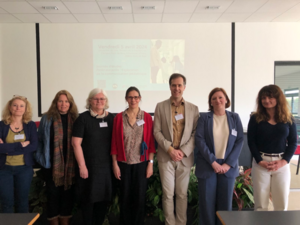Parler aux petits : Exploration de la communication pédiatrique – Talking with tinies: Exploring pediatric discourse
On Friday, April 5, 2024, a workshop was held at the University of Lille, Parler aux petits : exploration de la communication pédiatrique – Talking with tinies: Exploring pediatric discourse.
It was organized with a view to disseminating the results of PANIC2, a 3i project with as main partners the University of Lille, the University of Kent, UZGent, complemented by UZLeuven staff for the follow-up IMPACT project. Both projects, Pragmatic ANalysis of Interaction between Children and medical Caregivers in hospitals and Interaction in the Medical world: Pragmatic Analysis of Child-centered Talk, have as their main focus communication between healthcare professionals (HCPs) and children during medical consultations and procedures. Our aim is to examine how a linguistic perspective can shed light on verbal and non-verbal communication techniques used, and how, ultimately, such analyses can contribute to an enhanced healthcare.
This workshop consisted of talks that summed up the results of research carried out by the 3i team, and additional talks by HCPs and international researchers with expertise in the field of medical discourse. The day ended with a round table. Ilse Depraetere, who initiated the 3i project, teamed up with Bert Cappelle, a linguist from University of Lille who organizes the monthly linguistics seminars, to organize this event.

The speakers and public came from various backgrounds and included parents, researchers in linguistics and philosophy, medics (nurses, pediatricians, GPs), MA students in linguistics and from medical schools, and PhD students in linguistics, psychology and neurosciences. This varied mix was precisely what the organizers had hoped to achieve. With some 50 attendees, the event sparked lively debate and cross-fertilization. Comments such as “I didn’t know that this is what linguists do” and “I wasn’t aware that medics pay so much attention to how they talk to children” underscored the mutual learning and new perspectives gained.
The main questions addressed were: How do adults communicate about and with children in healthcare settings? Do doctors and nurses converse mostly with parents during medical encounters, thereby relegating the child to the role of bystander? Or do they develop verbal and non-verbal strategies to help calm anxious children and to give them a central voice? And how do parents help shape the discursive dynamics of this triad?
The introductory presentation set the scene: the general agenda was explained, the programme of the day announced, and a first part of the PANIC2 results presented. The focus was on the vocabulary used by the pediatrician in a consultation that took place in UZGent (Belgium). In a video fragment, the doctor was shown preparing a 5-year-old boy, accompanied by his mother, for an invasive eye laser procedure. It became clear that she used a lot of positive words (fun, cool), avoided reference to pain and things scary, in order not to activate negative emotions. So far, this conforms with what are standard recommendations for medics. But it was shown that her use of modal verbs was also very telling, for instance, in that she never imposed (through the use of have to or must) but rather referred to what the boy could do (can, may) and inquired into what he was willling to do (will), and this way gave him agency.
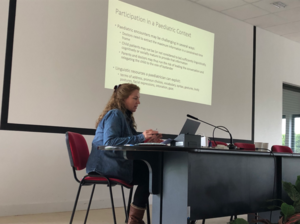
There were two further PANIC2 presentations, based on the analysis of the same consultation. The first one, The linguistic stepping stones to calming an anxious child patient, was presented by Vikki Janke (University of Kent) and Stéphanie Caët (Université de Lille). Vikki conducts research on first language acquisition in both typical and atypical development, and on second language acquisition in spoken and signed languages. Stéphanie’s expertise is likewise child language development. She analyses spontaneous interactions involving children, collected in homes, nurseries and speech and language therapy sessions, making use of a multimodal (vocal and gestural) approach to language. Their presentation illustrated how the HPC makes the child central in this triadic, thanks to the use of carefully chosen address terms, prosody, co-speech gestures, and gaze, which collectively established the child as the reference point and maintained him as the main addressee throughout.
Ilse Depraetere gave the final PANIC2 presentation. Her field of expertise is pragmatics; she has researched the ways in which meaning comes about in context, with special attention to in/directness and implicitness in communication. In her presentation Engaging a child during a consultation: a perspective from facework theory she showed that this specific linguistic model is very helpful in explaining the verbal techniques used by the doctor to make the child feel at ease. Importantly, it also makes it possible to capture the techniques in terms of one single principle. The general upshot of the PANIC2 linguistic analysis was that HCPs use a whole range of verbal and non-verbal means to turn the child into an agent, and that these move well beyond the ‘right (positive) words’. Making these techniques explicit, in accessible linguistic terms, can make HCPs better aware of what effects they achieve by doing what they do and can ultimately contribute to better health outcomes.
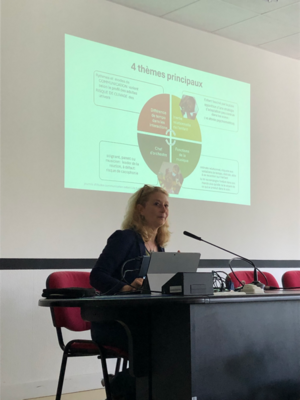
Bénédicte Lombart (Groupe hospitalier Sorbonne Université, LIPHA, Université Gustave Eiffel) and Lucy Bray (Edge Hill University) are HCPs who are active in initiatives that aim to turn procedures and consultations into better experiences for children. Bénédicte is one of the founding members of Pédiadol. Her talk focused on the concept of transient empathic blindness (cécité empathique transitoire). This concept refers to procedural contexts in which the child temporarily ‘disappears’, in spite of actors nevertheless striving to provide the best possible care: Quand la cécité empathique transitoire des adultes rencontre l’inertie relationnelle de l’enfant. She presented the results of a study in which musicians are present during consultations, in order to test the beneficial effect of music. Musicians trained to work in medical contexts were invited and together with a colleague, Bénédicte examined if and how their presence affected the behaviour or children, HCPs, and parents.
Lucy is one of the driving forces behind the I-SUPPORT project, the International collaborative rights-based standards to SUpport Paediatric Patients during clinical prOcedures by Reducing harm and establishing Trust. She is particularly interested in the education, information needs and preparation of children and their parents. The starting point of her talk was that children not well prepared or informed about what will happen can experience anxiety and distress and may need to be held. She presented the results of a study in which children themselves were asked what questions they had about the procedures and what information they wanted to receive. By listening to the child’s voice about their needs, they can be better prepared and cope with a procedure.
Demi Krystallidou’s (University of Surrey) research is focused on multi-lingual contexts. She investigates consultations in which an interpreter is called upon and how this impacts on the dynamics of the exchange. She presented a case study: “Are you the interpreter, then?” When a bilingual child patient holds the reins of mediated communication in a language-discordant medical consultation. She showed how a bilingual 10-year-old child, who, unlike her dad, was proficient in the doctor’s mother tongue, gradually gained increased autonomy and took control. She described how this resulted in a clash between the two professional authorities (the doctor and the interpreter) and parental authority.
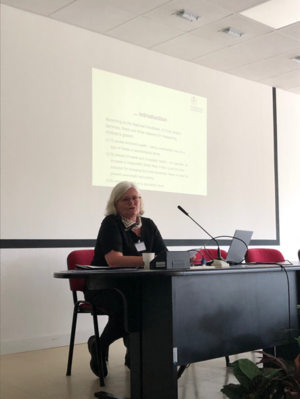
Camilla Rindstedt (Stockholm University) is a social anthropologist who has conducted ethnographic studies on communication between children, HCPs and parents in a pediatric cancer clinic in Sweden. She is currently leading a project which studies interaction between fathers and nurses in child healthcare and she presented some of the initial results in her talk, Growth curves and child’s weight: Normality and nurse-parent interaction at a Child Health Center. She zoomed in on discussions about growth curves and child’s weight, combining conversation analysis and linguistic anthropology as methodologies. She showed how advice by nurses is often indirect and how parents tend to engage in ‘mind-reading’, spelling out nurses’ advice in advance.
Each of the talks gave rise to lively debate, which was continued during the coffee breaks and over lunch.
At the round table, all speakers, and Lies Cremers, the UZLeuven IMPACT member of the team, gathered and engaged in discussion with the participants. Bénédicte presented the activities of Pédiadol and Lies spoke about PROSA, the European organisation for Procedural Sedation and Analgesia, which aims to make procedures trauma-free and more enjoyable for children. They both stressed again that non-pharmacological methods, including language, are important throughout the process. Both associations offer various types of training programmes, which also address communication techniques. And both organize annual conferences where HPCs can exchange views and share experiences.
Among the factors that were discussed were the importance of age, and the need to adapt one’s language to the socio-cognitive development of children. At the same time, irrespective of age, as Bénédicte explained, things get out of hand if the child is “out of him/herself with anxiety”, and no longer in the “here and now”. It can be important to simply stop the procedure, tell the parents to take the child for a walk, or simply walk around in the room with the child until they are again ‘present’. ‘How to tell a kid to undress?’ was one of the very practical topics that came up, as well as the crucial role of parents in medical consultations. One medic pointed out that more often than not, it is the parents that are anxious, thereby transferring their anxiety to the children. Parents are often “former traumatized children”, as Bénédicte put it. But things also work out for the best, as became clear when a CHU Lille pediatrician shared a telling anecdote with the audience. She recalled a recent procedure with a 5-year-old, who had a blood sample taken. He left the procedure room but then ran back and cried out energetically: “Having a blood sample taken! How cool is that!” (Une prise de sang, comme c’est cool!).
The workshop was a warm gathering of people who care about pediatric care and are open-minded about sharing experiences and learning from others and other domains, with very constructive interactions resulting. It created a space for fruitful interdisciplinary collaboration and showed that there is still a lot of ground to be covered.
One of the next steps in the IMPACT project is a fully anonymous questionnaire aimed at parents. It is our aim to disseminate it, not in hospitals or GP practices, but rather through non-medical social networks, schools, municipal offices, etc. – any space where parents of children between 3 and 11 years old are likely to be found. So here’s a call for participation! If you have a child in that age range, or if you know people who do, and if you/they have taken your/their child to a doctor in the past two months, please fill in or invite them to fill in the questionnaire. As we aim to collect data in France, Belgium and the UK, there are three versions (French, Dutch, English).
The full programme and abstracts of the talks presented at the workshop are available here:
How do adults communicate about and with children in healthcare settings? Do doctors and nurses converse mostly with parents during medical encounters, thereby relegating the child to the role of bystander? Or do they develop verbal and non-verbal strategies to help calm anxious children and to give them a central voice? And how do parents help shape the discursive dynamics of this triad?
We will explore these questions by bringing together healthcare practitioners, parents, and linguists, and by unpicking concrete examples of healthcare conversations involving children. The aim of the workshop is to learn from each other’s experiences and perspectives. We are convinced that our ability to respond effectively to the challenges specific to pediatric communication can be improved substantially by linguistic insights into general conversational processes. Conversely, we also want to establish interaction involving children in healthcare contexts as a domain of linguistic investigation.
9.30 - 10.00 | Welcome
10.00 - 10.30 | Bert Cappelle & Ilse Depraetere (Université de Lille, UMR 8163 STL Savoirs Textes Langage)
10.30 - 11.00 | Vikki Janke (University of Kent) & Stéphanie Caët (Université de Lille, UMR 8163 STL)
11.00 - 11.30 | coffee break
11.30 - 12.00 | Ilse Depraetere (Université de Lille, UMR 8163 STL)
12.00 - 12.30 | Demi Krystallidou (University of Surrey)
12.30 - 14.00 | lunch break
14.00 - 14.30 | Bénédicte Lombart (Groupe hospitalier Sorbonne Université, LIPHA, Université Gustave Eiffel)
14.30 - 15.00 | Lucy Bray (Edge Hill University)
15.00 - 15.30 | coffee break
15.30 - 16.00 | Camilla Rindstedt (Stockholm University)
16.00 - 16.30 | Round table and discussion (presenters and Lies Cremers, UZ Leuven)
Practical information
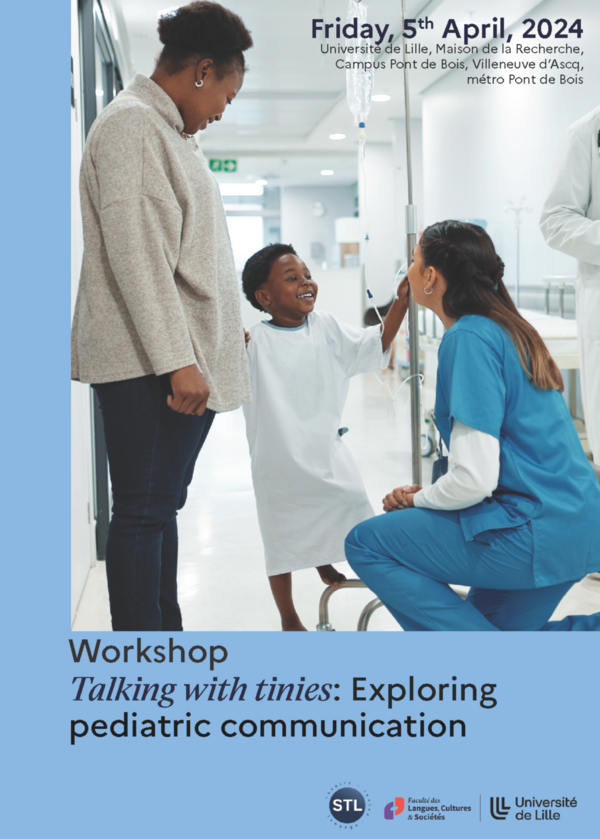
Where?
Maison de la Recherche (building F) of the University of Lille,
Campus Pont de Bois, Villeneuve d'Ascq
When?
Friday, April 5 at 9:30 AM - 16:30 PM
Participation costs ?
Free event – registration required
Call for participants!
Online questionnaire for parents of children aged 3 - 11 years old
Information about the questionnaire is provided here.
Links to the questionnaires
Contacts
For questions about the 3i projects or suggestions, please contact ilse.depraetereuniv-lillefr
